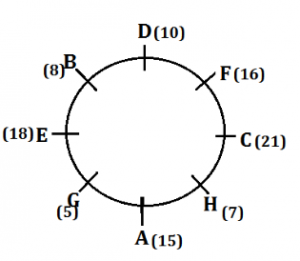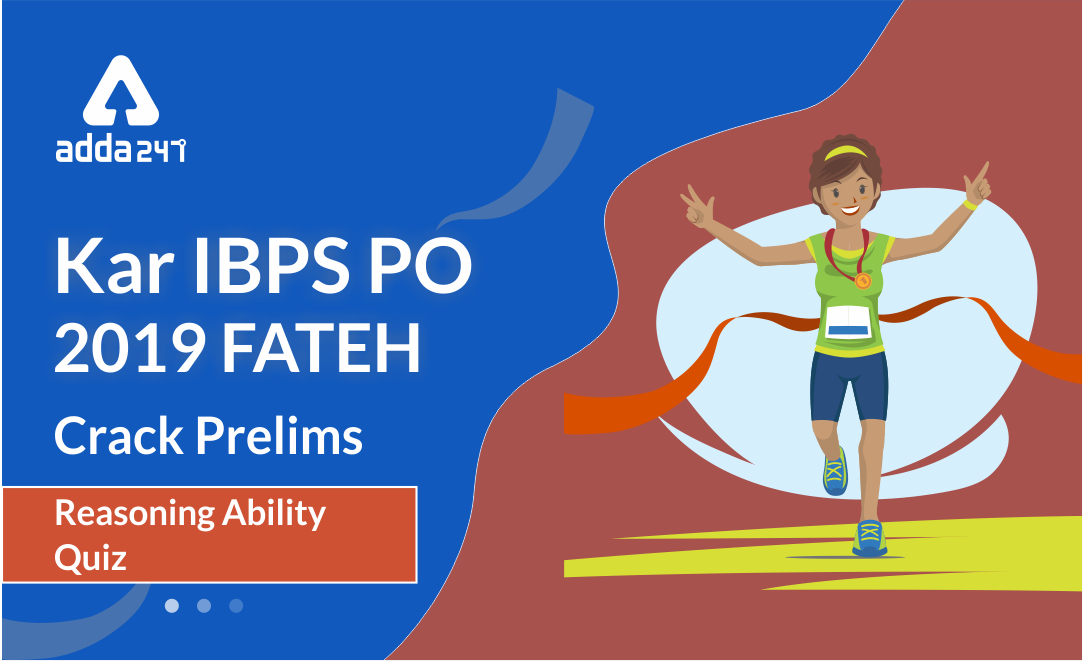The reasoning being the scoring part can enhance your performance as a whole. All you need to do is clear your basics and be aware of the syllabus of the particular exam you are preparing for. Study Notes for the topics like Puzzles, Coding-decoding, sitting arrangement, blood relations, and the list is long is provided on Adda247, so that you can make the preparation time fun by cracking the logic that runs the engine of a particular topic. Giving mocks and Quizzes on a regular basis will help you to decode the strategy. Also, the Study Plans go hand in hand with the exam preparations that will take place in the upcoming months. Like the IBPS PO Prelims are scheduled in the month of October and we already rolled the study plan ‘Kar IBPS PO 2019 FATAH’ for your aid. Under the same plan, here is the Quiz for Reasoning, to make sure that you don’t skip any important topic as well as be prepared to face any type of questions in the prelims. IBPS PO Reasoning Quiz of 6th October 2019 covers Miscellaneous Topic.
Directions (1-5): Study the following information carefully to answer these questions carefully.
Eight children are seating around a circular table and all of them faces inside of the table. Each of them has different number of chocolates- 5, 7, 18, 8, 10, 16, 21 and 15, but not necessarily in the same order.
The one who has 21 chocolate sits second to the right of A. G sits opposite to F. An immediate neighbor of A sits opposite to B, who has number of chocolates which is a perfect cube of a number. H sits third to the left of D, who has number of chocolates which is multiple of 5. A has 15 chocolate and sits second to the right of that one, who has 18 chocolate. An immediate neighbor of D has 8 chocolate. F has 16 chocolate and sits next to D. G sits immediate right of E, who sits opposite to C. The number of chocolate D have is 2 times the number of chocolates of G.
Q1. B has how many chocolates?
(a) 18
(b) 5
(c) 16
(d) 8
(e) None of these
Q2. How many persons sit between A and D?
(a) Five
(b) One
(c) Two
(d) Three
(e) None
Q3. Who among the following have 21 chocolates?
(a) C
(b) D
(c) E
(d) F
(e) None of these
Q4. What is the difference between number of chocolates F and G have?
(a) 8
(b) 11
(c) 12
(d) 10
(e) None of these
Q5. Who among the following sits third to the left of the one who has 10 chocolates?
(a) E
(b) G
(c) H
(d) B
(e) None of these
Solutions (1-5):
S1. Ans.(d)
S2. Ans.(d)
S3. Ans.(a)
S4. Ans.(b)
S5. Ans.(c)
Directions (6-10): Study the following information carefully and answer the questions given below:
In a certain code language
‘change attitude people’ is written as ‘th vo ma’,
‘choice comfort outside’ is written as ‘sa ra ta’,
‘people comfort success’ is written as ‘ps vo sa’,
‘review nation change’ is written as ‘th ha gk’.
Q6. What is the code for ‘change’?
(a) gk
(b) ha
(c) th
(d) ma
(e) None of these
Q7. What may be the code for ‘review nation choice’?
(a) gk ha ta
(b) ta ra ha
(c) ha gk ra
(d) Either (a) or (c)
(e) None of these
Q8. What is the code for ‘review’?
(a) gk
(b) th
(c) ps
(d) ha
(e) Can’t be determined
Q9. What does ‘ps’ stand for?
(a) comfort
(b) success
(c) attitude
(d) nation
(e) None of these
Q10. What is the code for ‘comfort’?
(a) gk
(b) th
(c) sa
(d) ha
(e)None of these
Solutions (6-10):

S6. Ans.(c)
S7. Ans.(d)
S8. Ans.(e)
S9. Ans.(b)
S10. Ans.(c)
Directions (11-15): In these questions, relationship between different elements is shown in the statements. The statements are followed by conclusions.
Give answer
(a) If only conclusion I is true
(b) If only conclusion II is true
(c) If either conclusion I or II is true
(d) If neither conclusion I nor II is true
(e) If both conclusions I and II are true
Q11. Statements: N > P ≥ M< T=U
Conclusions: I. N > T II. U = P
Q12. Statements: D ≤ B=A > E ≥ F
Conclusions: I. D = F II. A > F
Q13. Statements: W= S ≥ Q ≥ T > X
Conclusions: I. W > X II. S < T
Q14. Statements: U ≥ W > S = K ≤ Z
Conclusions: I. U > K II. Z = S
Q15. Statements: D < K ≥ G > E < S
Conclusions: I. S > D II. D< E
Solutions (11-15):
S11. Ans.(d)
Sol. I. N > T (false) II. U = P (false)
S12. Ans.(b)
Sol. I. D = F (false) II. A > F(true)
S13. Ans.(a)
Sol. I. W > X(true) II. S < T (false)
S14. Ans.(a)
Sol. I. U > K(true) II. Z = S(false)
S15.Ans.(d)
Sol. I. S > D(false) II. D>E(false)
If you are preparing for IBPS PO Exam, then you can also check out a video for Reasoning below:
You may also like to Read:





 GA Capsule for SBI Clerk Mains 2025, Dow...
GA Capsule for SBI Clerk Mains 2025, Dow...
 The Hindu Review October 2022: Download ...
The Hindu Review October 2022: Download ...
 Kamyab Divas Event: A Historic Success
Kamyab Divas Event: A Historic Success







